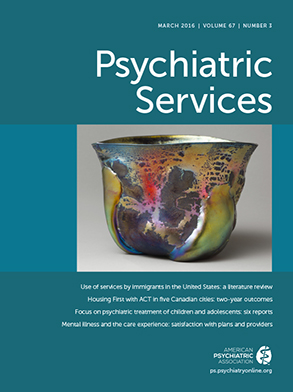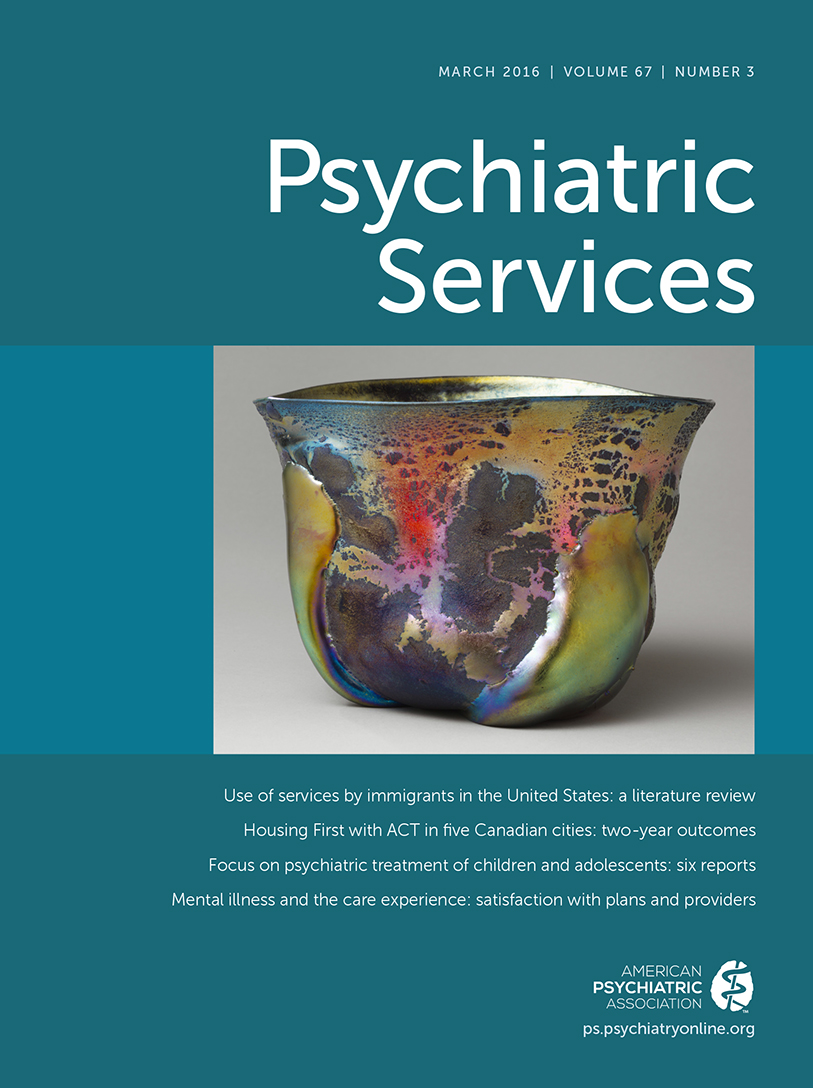The behavioral model of treatment seeking suggests that service use is shaped by predisposing factors, such as demographic characteristics, preexisting psychological symptoms, and exposure to stressors and traumatic events; illness-related factors, such as the severity of mental or general medical symptoms; and enabling factors, such as resources that increase access to adequate services, such as insurance and employment (
3). A review cited evidence for the applicability of the behavioral model among disaster survivors (
4). However, although the behavioral model recognizes the role of perceived need in help seeking, none of the reviewed studies examined service use among survivors with perceived need for services.
The aim of this study was to examine factors within the behavioral model that predicted service use among Hurricane Ike survivors with perceived need for services by using data from a three-wave, population-based study. Given the lack of research on this topic, our analyses are best conceptualized as exploratory. As such, we did not prepare specific hypotheses regarding which predisposing, illness-related, and enabling factors would be associated with service use among participants with perceived need.
Methods
Data were from the Galveston Bay Recovery Study (GBRS), a population-based epidemiologic study of mental health in the aftermath of Hurricane Ike. Information about the GBRS sampling strategy can be found elsewhere (
6). Wave 1 (W1) telephone interviews were conducted two to six months after the disaster, between November 7, 2008, and March 24, 2009 (N=658), and the overall response rate was 40% (
www.aapor.org/Resources_for_Researchers.htm). Participants were reinterviewed via telephone twice: 529 (80%) participants completed a wave 2 (W2) interview five to nine months after the disaster (February 6, 2009, to June 29, 2009); and 487 (74%) participants completed a wave 3 (W3) interview 14 to 19 months after the disaster (November 19, 2009, to April 13, 2010). Institutional review boards of the University of Michigan, Dartmouth College, and Yale University approved the study, and participants provided oral informed consent. [Demographic characteristics of the sample and other descriptive data are available in an
online supplement to this report.]
Perceived need for services was assessed with the Perceived Need for Care Questionnaire (
7). Participants indicated (yes/no) whether they perceived a need for five mental health services. At W1, items referred to the time period since Hurricane Ike, and at W2 and W3, items referred to the time period since the previous interview. Participants who endorsed one or more areas of perceived need were asked to indicate (yes/no) whether they used eight mental health services. [A list of the areas of mental health need and the types of mental health services included in the survey is available in the
online supplement.] At each wave, participants who reported a need for services were divided into two groups: those who reported using or not using any service (1 or 0, respectively).
Predisposing factors included demographic characteristics, lifetime mental health before the disaster, and exposure to disaster-related and general traumatic events and stressors. Demographic characteristics were assessed at W1 and included gender, race-ethnicity, marital and parent status, employment before the disaster, and age.
Lifetime mental health before the disaster was assessed retrospectively at W1. To determine whether participants had probable posttraumatic stress disorder (PTSD) before the disaster, participants completed an inventory of traumatic events they had experienced before the disaster (
8). Those who experienced trauma before the disaster completed the PTSD Checklist–Civilian Version (PCL-C) in reference to the event they considered the worst experience, and
DSM-IV criteria were applied to determine probable PTSD. To determine whether participants had probable major depressive disorder (MDD) and generalized anxiety disorder (GAD) before the disaster, participants completed the Patient Health Questionnaire–9 (PHQ-9) and the Generalized Anxiety Disorder (GAD-7) scale, respectively, in reference to any lifetime two-week period. Additional items assessed whether symptoms occurred together and age of onset. Participants with scores of 10 or greater with symptoms occurring together with onset before the disaster were classified as having probable MDD and GAD, respectively, before the disaster (
9,
10).
Exposure to disaster-related traumatic events and stressors was assessed at W1. Participants indicated whether they had endured four disaster-related traumas, such as physical injury and bereavement, and seven disaster-related stressors, such as displacement and property loss. Counts of affirmative responses to each inventory were included in the analysis (
11).
General traumatic events and stressors were assessed at each wave. Participants indicated whether they had experienced 20 traumas (
8)—for example, unwanted sexual contact or sudden unexpected death of someone close—and 12 stressors (
12)—for example, serious financial problems and divorce or breakup—and the number of affirmative responses were counted. At W1, participants indicated whether a trauma or stressor had occurred before or after the disaster or was disaster related, and only events that occurred after the disaster but were unrelated to the hurricane were included. At W2 and W3, participants were asked about events since the previous interview.
Illness-related factors included posttraumatic stress, depression, generalized anxiety, and quality of life. Posttraumatic stress was assessed using a modified version of the PCL-C (
13). Participants rated how much they were bothered by 17 symptoms (for example, having repeated, disturbing thoughts or memories of Hurricane Ike and avoiding activities or situations because they remind you of Hurricane Ike) since the hurricane (W1) or prior interview (W2 and W3) from 1, not at all, to 5, extremely (Cronbach’s α=.92–.96). The PHQ-9 (
9) assessed past-month depression and the GAD-7 (
10) assessed past-month generalized anxiety at each wave. Participants indicated whether there was ever a two-week period during the prior month in which they were bothered by each symptom (for example, feeling down, depressed, or hopeless [PHQ-9] and feeling nervous, anxious, or on edge [GAD-7]) and, if so, how often they were bothered by the symptom, from 0 (not at all) to 3 (nearly every day) (PHQ-9, α=.79–.89; GAD-7, α=.84–.88). The Quality of Life Enjoyment and Satisfaction Questionnaire (
14) assessed past-month quality of life. Participants rated the extent to which they were satisfied with 14 aspects of their lives (for example, “physical” health and social relationships) during the past month from 1, not at all, to 5, extremely (α=.91–.92).
Enabling factors included insurance coverage and past-week employment at each wave (yes or no). The Inventory of Postdisaster Social Support (
15) was used to measure frequency of support from friends and family members, from 1, never, to 4, many times
, since the hurricane (W1) or previous interview (W2 and W3). The inventory included three items for emotional social support (α=.78–.80), such as being comforted by a hug or another sign of affection; three items for informational social support (α=.73–.76), such as being provided information on how to do something; and five items for tangible social support (α=.69–.73), such as being given, loaned, or offered money.
Data analysis consisted of two steps. First, we computed the frequency with which participants reported any perceived need as well as use of any services by participants who reported perceived need at each wave. Second, we conducted a logistic regression model predicting service use among participants with perceived need by using a generalized estimating equations (GEE) approach. Both fixed (between-subject) and time-varying (within-subject) variables can be entered into the analysis. The results provide insight into between-subject effects, rather than change within individuals, and estimates are therefore analogous to those from standard regression analysis. In the current study, a GEE approach allowed us to include participants who reported perceived need at some, but not all, waves and autocorrelated data for participants who reported perceived need at multiple waves. The approach to handling missing data in GBRS is described elsewhere (
6).
Discussion
The purpose of this study was to explore predisposing, illness-related, and enabling factors as predictors of mental health service use among disaster survivors with perceived need for services. Participants were from a three-wave, population-based study in the aftermath of Hurricane Ike. The only predictors to reach statistical significance were a predisposing factor (more general stressors) and an enabling factor (insurance coverage). The results are consistent with prior studies of perceived need and service use unrelated to disaster exposure. Those studies, which involved limited samples and cross-sectional data, also found that that few factors within the behavioral model predicted service use among persons with perceived need (
2,
5).
The results provide insight into the factors that combine with perceived need to facilitate service use, given that perceived need is a necessary but insufficient condition of service use. For survivors with perceived need, general stressors may have provided an additional rationale for seeking services or led to encounters with nonprofit or social service organizations that make mental health referrals. Insurance coverage could lead to increased service use by helping survivors with perceived need to identify providers, for example, through insurance companies’ online directories, or by reducing anticipated or actual costs.
At least four limitations of the study are worth noting. First, we assumed that participants without perceived need for services did not use them, which might not always have been the case. Second, mental health status, disaster exposure, and other intervening events experienced after the disaster likely influenced the retrospective assessment of lifetime mental health before the disaster. Third, although the response rate (40%) was consistent with other population-based studies in the field, potential systematic differences between persons who opted to complete the study and those who did not limit the external validity of the study. Fourth, the results might be unique to the study sample, and replication is needed in the aftermath of other disasters, including disasters that entail a greater threat to life and destruction or that affect countries with varying health care systems.
Further research is also needed to understand causal pathways from general stressors and insurance coverage to service use among disaster survivors with perceived need. The results provide evidence, however, that expanding access after a disaster to services that do not require insurance could better meet survivors’ needs.

